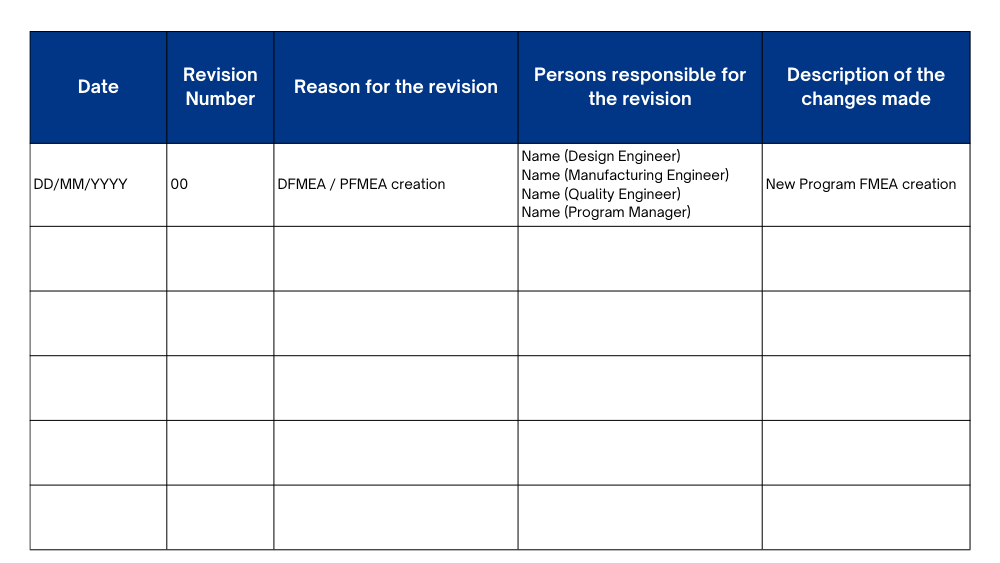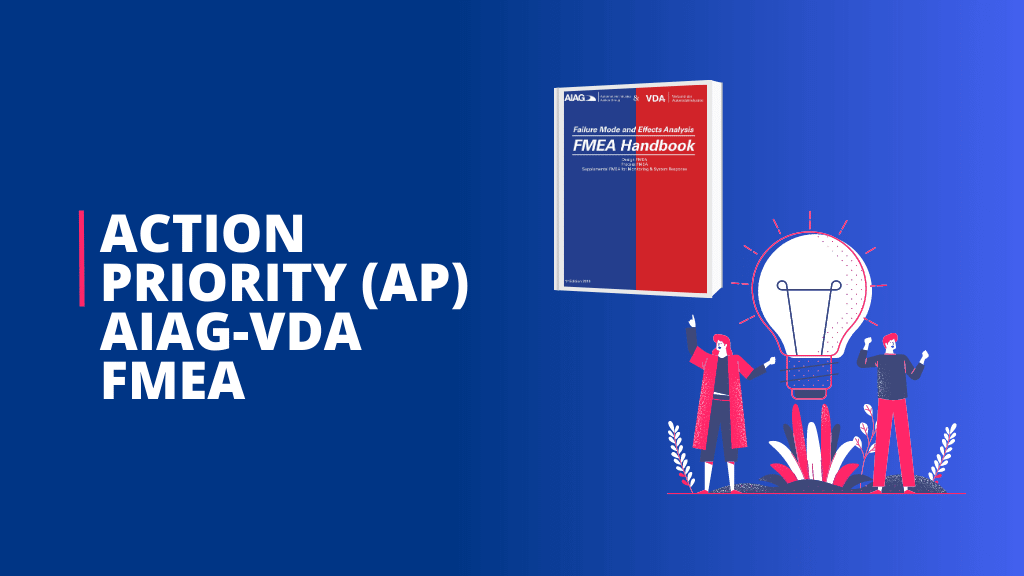This post will teach you about the FMEA updates, review, and revision requirements.
FMEA must be updated in which scenarios?
We will see the two scenarios here When DFMEA is updated? And when PFMEA is updated? …
DFMEA update in which condition: Design FMEA
Some scenarios in which DFMEA should be updated include:

- Changes in design
- New or updated regulations
- Customer Claim / Warranty Failure / Feedback from the field
- New or updated materials and processes
- Changes in suppliers
Changes in design: If we have a change in the product design. We need to update the DFMEA to capture all new / updated design failure and their effects. We should analyze the potential risk of this new design.
New or updated regulations: If there are any changes in the regulation requirements or standards. If those changes affect our product then we should update our DFMEA. So, in this case, we ensure that our product will be compliance with new regulation requirements and standards.
Customer Claim / Warranty Failure / Feedback from the field:
1) If there are some issues/claims by the customer.
2) If there are some warranty/field issues reported by the end users.
We should update our DFMEA to add such risk and identify the actions to prevent future failures.
New or updated materials and processes: If new materials or production processes are implemented. Then DFMEA should be update to assess their impact on the product’s failure modes and effects.
Changes in suppliers: Due to changes in suppliers/external parties, there must be some risk to our product. Therefore DFMEA should be update to identify the potential failure mode and their effects associated with new suppliers.
Overall, DFMEA will be treated as a living document and it needs a regular updates to ensure that all potential failures are identified and addressed as soon as possible it needs an update.
PFMEA update in which condition: Process FMEA
Like DFMEA, PFMEA is a living document and that should update regularly throughout the product development and production cycle to ensure that potential failures are identified and addressed.
Some scenarios in which PFMEA should be updated include:

- Changes in process
- New or updated regulations
- Customer Complaint & Claims / Warranty Return
- Feedback from the production line
- New or updated materials
- Changes in suppliers
Changes in process: If there are any changes to the production processes, PFMEA should update. This is to reflect those changes and assess their impact on the production process failure modes and effects.
New or updated regulations: If there are any changes in the regulation requirements or standards. If those changes are affects our production process or product, then we should update our PFMEA. So, in this case, we ensure that our product will be compliance with new regulation requirements and standards.
Customer Complaint & Claims / Warranty Return: If there are any issues/failures identified and reported by the customer, PFMEA should update in this condition. This is to ensure that we have updated our PFMEA to capture the customer complaint failures.
Feedback from the production line: If there are any issues/failures identified and reported by production line workers, PFMEA needs to update to address these issues and prevent them from happening in the future.
New or updated materials: If new materials are considered in the production process, PFMEA needs to update to assess their impact on the production process failure modes and effects.
Changes in suppliers: Due to changes in suppliers/external parties, there must be some risk to our production process. Therefore PFMEA needs to update to identify the potential failure mode and effects associated with new suppliers.
FMEA review and update frequency
The frequency of FMEA reviews and updates depends on various factors, such as
– The complexity of the product
– The level of risk associated with the product
– The regulatory requirements.
So, FMEA should be considered a living document that requires regular review to remain effective.

However, below are some general guidelines we should consider to review and update frequency:
- During the design Phases
- After Production Launch
- When new risks are identified
- After Failure event (Inhouse/customer/warranty issue)
- At regular frequency (Periodic)
During the design phase: During the transition of Product/Process develpement phases FMEA needs to review and update.
After production launch: FMEA needs to review and update. Review and revise the DFMEA & PFMEA during mass production to ensure the accuracy and completeness of the analysis as compared with the production design.
When new risks are identified: This is the case when we do reverse FMEA. In this case, FMEA is reviewed by the team and new risks are identified.
Periodically: FMEA needs to review and update at a defined frequency. Typically once a year or every two years, to ensure effectiveness and relevance.
After a failure event: FMEA needs to review and update after a failure event to address the root cause of the failure and prevent it from happening in the future.
How to update the FMEA
Refer below some steps can be followed to update FMEA:

Gather data: Collect relevant data and information, such as customer feedback, field failure data, new design or process changes, and updated regulations or standards.
Review the current FMEA: Analyze the existing FMEA document to identify any potential gaps or outdated information.
Identify the need for updates: Identify the failure modes, effects, and causes that require updates based on the data gathered. What actual Action priority do we have?
Prioritize the updates: Prioritize the updates based on their potential impact on the product, customer safety, and compliance with regulations.
Update the FMEA: Make the necessary changes to the FMEA document, including adding new failure modes, causes, effects, and control measures.
Review and approve the updates: Review the updated FMEA with the cross functional team. Which includes stakeholders, designers, engineers, quality control, and project managers, and getting their approval.
Implement the updates: Implement the changes and monitor their effectiveness to ensure that potential risks have been addressed.
Communicate the updates: Communicate those updates to all relevant parties, including suppliers, manufacturers, distributors, and customers, to ensure that everyone is aware of the changes in the FMEA.
Overall, FMEA updates process requires a systematic approach to ensure that potential risks are identified and addressed correctly. It is essential that the CFT team is involved in the review and approval process.
FMEA revision history
Revision history is nothing but the record of changes made in the FMEA documents over the period of time.
This history will help us to provide information about the updated record, revisions, and modifications in the FMEA documents, dates of changes, and persons who are there for those changes and reasons for change. Therefore we can easily track down the evolution of our Product design / Production Process development.
Typically, the revision history includes information as below:
- Date of each revision: The date when each revision was made.
- Revision number: A unique identifier for each revision for ex. 01, 02, 03 OR A, B, C etc.
- Reason for the revision: The reason why the revision was made, such as design changes, new regulations, or customer feedback.
- Person responsible for the revision: The name of the person who made the revision.
- Description of the changes made: A brief description of the changes made to the FMEA document.

Finally, the revision history needs to be updated each time the FMEA document is revised or updated.
Conclusion
Overall, the FMEA is updated in scenarios such as Product/Process change, New or updated regulations, Customer Complaints & Claims/Warranty Returns, New or updated materials, Changes in suppliers, etc.
the FMEA is updated in scenarios such as Product/Process change, New or updated regulations, Customer Complaints & Claims/Warranty Returns, New or updated materials, Changes in suppliers, etc.
Gather data, Review the current FMEA, Identify the need for updates, Prioritize the updates, Update the FMEA, Review and approve the updates, Implement the updates, and Communicate the updates.
It is the record of updates made in FMEA documents over the period of time.
Date of each revision, Revision number, Reason for the revision, Person responsible for the revision, and Description of the changes made.






